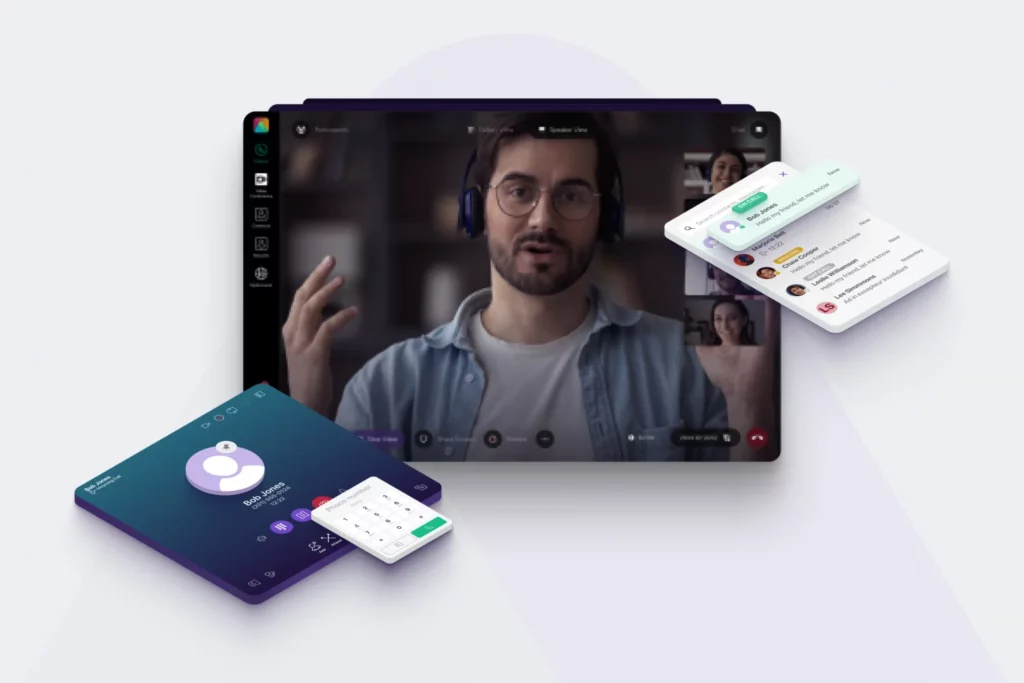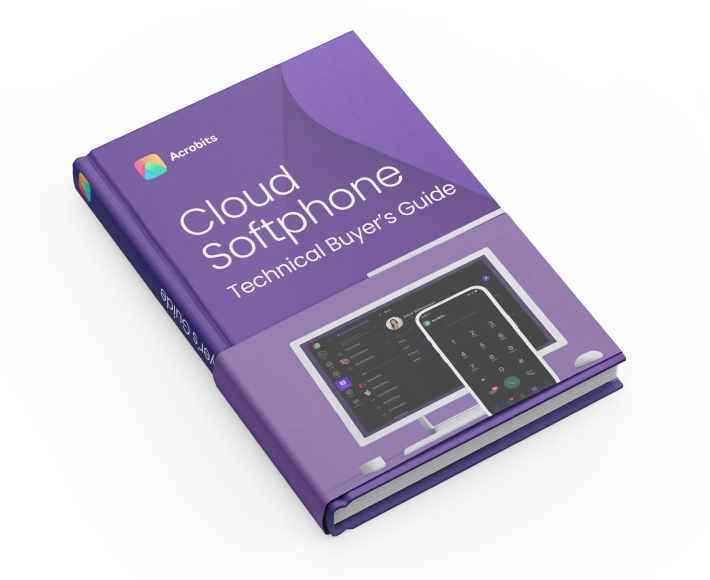What is VoIP?
VoIP, or Voice over Internet Protocol, enables making phone calls via the internet instead of traditional phone lines.
It converts your voice into digital signals, transmitting them over the web, allowing for calls on any device with internet access, including computers, smartphones, or VoIP-enabled phones.
This technology supports features like selecting area codes, direct inward dialing, and portability, offering a flexible and cost-effective communication solution.
Voice over Internet Protocol — or VoIP is the acronym to remember, but let’s dig into what each term in it means. As expected, VoIP is capable of transmitting your voice to a remote location using the Internet. It’s essentially a phone service that’s cheaper because it doesn’t require dedicated phone lines or copper wiring.
Exploring VoIP’s Flexibility
Communication is the lifeblood of your business, especially as companies expand into multiple locations and employees choose to work remotely more often.
While most organizations have telephone services and fax machines figured out, the adoption of VoIP technologies is the largest step towards a more robust collaboration system in a long time.
This comprehensive guide will cover all the details and advantages of VoIP, the technologies behind it, and how it can contribute to the future success of your business.
Other terms you might have heard are “broadband phones” and “Internet telephony,” but VoIP is the most popular term to use by far in the IT space.
How Does VoIP Work?
VoIP works by converting your voice into digital data, sending it over the internet, and then converting it back at the recipient’s end for clear audio communication.
It’s efficient and adaptable, bypassing traditional phone lines for direct internet-based calls, making it ideal for both personal use and modern business needs. With technologies like PBX for network management, SIP for call setup, and codecs for data compression, VoIP ensures seamless, high-quality calls across various devices and locations.
To be a little more specific, imagine you’re making a VoIP call from your smartphone to a recipient on his laptop. The calling device converts your voice into digital data packets. Those packets are sent over the Internet to the destination device, which converts that data back into your voice for the recipient to hear.
What is the Tech and Infrastructure Needed for VoIP?
Compared to traditional telephones, VoIP is far more cost-effective and flexible for modern business demands. But it’s also worth going over some of the specialized terms and tech that detail exactly how the system works and what’s needed to make it function:
- PBX: No matter what type of deployment you’re using, all of these VoIP systems work on a Private Branch Exchange (PBX), a private telephone network common for business use.
- SIP: A Session Initiation Protocol is a signaling protocol used to initiate, maintain, and terminate a VoIP session.
- SIP Trunking: This methodology is used to connect a PBX with a traditional phone line. If you want to use existing communication equipment in your business to integrate with VoIP, you’d use some form of SIP trunking.
- DHCP: The dynamic host configuration protocol assigns unique IP addresses to each client device in a VoIP network. VoIP phones themselves can have either a static or dynamic IP under a DHCP.
- Codec: Raw audio data can be unnecessarily large in size and eat into bandwidth. Codecs compress VoIP data to save on bandwidth and boost connection speed.
- PSTN: Standing for public switched telephone network, this global infrastructure connects the world’s cellular networks, telephone lines, and general communication devices together. The result is an international network that enables private and public telecommunication.
These mechanisms are what make Voice over Internet Protocol such a ubiquitous technology for businesses everywhere, regardless of location or industry.
What Is A VoIP Phone?
A VoIP phone enables calls over the internet using either an application on your device, a dedicated IP phone, or an adapter for traditional phones.
It merges the convenience of traditional calling with the flexibility of modern technology, ideal for both personal and business communication in a connected world.
VoIP phones are the tools used to interact with a VoIP service. There are several types of VoIP phones that you could use:
- Inter-computer: VoIP software can be run on any two computers, which can then establish a phone line by transmitting microphone or headset audio between the machines.
- IP Phones: These devices are essentially the VoIP equivalent of a traditional desk phone. They plug into a computer and provide VoIP services through your router or server.
- Analog Telephone Adaptors (ATA): Alternatively, you can reuse your traditional telephone for VoIP calling by plugging in an ATA to connect it to your computer. The analog signal from the phone is converted into digital data for VoIP use.
The choice of which option to use comes down to what current system you have for communication already. Some businesses already have an on-site phone line and want to make the transition to VoIP carefully, while others want to jump straight into a hosted service.

What Is A VoIP Number?
A VoIP number is an internet-based phone number that allows for customizable area codes, direct inward dialing, portability across locations, and access to toll-free options, enhancing flexibility and cost-effectiveness in communication.
VoIP numbers function similarly to real telephone numbers but differ in the sense that they are specific to individual users rather than an entire phone line that anybody can theoretically use. Also, VoIP numbers are not assigned to a specific location like traditional lines are.
VoIP numbers enjoy a few features:
- Choice of area code: VoIP providers allow you to choose any area code you want, even outside of your local area. Customers often find businesses more credible when they have local numbers to dial.
- Direct Inward Dialing: Businesses with VoIP numbers typically set up Direct Inward Dialing (DID) so that customers can call in and be instantly connected to a specific employee through an extension rather than go through a menu system.
- Number portability: Unlike with traditional phone lines, VoIP numbers are mobile in the sense that calls from a VoIP phone can happen anywhere while still keeping the same number. This way, you don’t have to change your numbers when moving and potentially annoy your customers and business partners.
- Toll-free numbers: Once a feature only larger enterprises could enjoy, toll-free calling is now available to growing businesses as well. It’s the perfect tool for minimizing friction during customer interactions.
Best of all, VoIP numbers are cheap to set up, even if you need plenty of them. Ask your VoIP provider about pricing plans.
Note: For a deeper understanding of this, you might benefit from our simple guide on what is a VoIP Number.
What is a VoIP App?
A VoIP app allows making calls over the internet using Voice over Internet Protocol technology, essentially turning any internet-connected device into a communication tool.
It offers the flexibility to call from smartphones, tablets, or computers, bypassing traditional phone lines for enhanced mobility and cost savings. These apps support features like video calls, text messaging, and voicemail, integrating seamlessly with business systems for efficient remote collaboration.
Given VoIP’s emphasis on internet-based communication, these apps embody the technology’s core advantages—portability, cost-effectiveness, and accessibility, aligning with the modern demand for flexible, anywhere-anytime communication solutions.
What are the Top VoIP Phone System Features?
And just as important are the features on offer. Make sure that your chosen VoIP phone service offers all the functions you’ll need in your business communication platform. A few examples that could be useful to you are:
- Auto-attendant: If you’ve ever called a business, you’ve likely heard an automated answering machine introducing you to the call before forwarding you to a customer service agent. Auto-attendants are popular for business use.
- Call routing: This feature is regularly used in phone centers to divert customer calls to the right service representative. The system can automatically route support tickets and inquiries to the right department or business location.
- Conferencing: Don’t limit yourself to one-on-one calling. Use conferencing features to bring your meetings online and keep your teams flexible.
- Integrations: VoIP platforms typically work well with other business tools like customer relationship management (CRM) software to share data and assist in business processes.
- Recording: It’s common for businesses to record customer calls to help train new sales representatives and prove compliance in heavily regulated industries.
- Reporting: Opportunities for data analytics can be found in tracking the number of calls to a certain center or the average duration of certain calls. This way, you can optimize your responses to customer complaints or other business communication.
- Transcription: Voice-to-text algorithms can turn your voicemails directly into readable text, saving employees time not having to listen to every message.
- Voicemail: In combination with call forwarding, voicemail allows employees to respond to calls later if any happen to be missed.
What Industries Use VoIP Technology?
The simple answer is almost all of them do. Or all of them could benefit from adopting VoIP service at least. A few notable examples of VoIP phone use cases include:
- Healthcare: Physicians nowadays are connecting with their patients remotely more than ever. In an age of digital healthcare, mobile connectivity is a must, and VoIP can be used to improve response times, provide medical assessment tools through data analytics, and generally save time and money.
- Hotels: Communication not only between staff members but also with guests helps encourage guest loyalty and facilitates the booking process. VoIP assists companies in the hospitality industry in multiple ways, from automating customer service to delivering wake-up calls on request.
- B2B sales: B2B businesses need to maintain a professional look for their clients, so white-label VoIP softphones are ideal in this scenario. Companies with these tools can add their own branding to the platform.
There are far more creative applications of VoIP technology everywhere. Even businesses that don’t see the benefit yet typically find immense value in VoIP once they’ve adopted it.
Also check:
Softphones history: how did business communication evolve over time?

Pros & Cons of VoIP
The truth is that there’s fairly little reason to stay with an older communication format than VoIP. Almost everyone will be on Voice over Internet Protocol within a few years, but let’s talk about the advantages and potential challenges of VoIP so that you have a solid picture before you make the upgrade.
Benefits of VoIP
- Cost: As mentioned, online communication—whether it’s by voice, video, or text—is considerably cheaper than traditional telephony thanks to not requiring the dedicated infrastructure and phone lines necessary for the latter. You also don’t have to pay the high service costs of cell phone services with VoIP.
- Fast installation: Because most VoIP services are provided by third-party vendors, your company doesn’t have to spend money, time, or IT resources to set up and maintain such a system yourself.
- Flexibility: While telephones are fairly limited in scope, VoIP goes beyond just voice calling and extends to text messaging, video conferencing, file sharing, chat rooms, and various other methods to work together.
- Quality sound: Traditional phones still use the copper cables from several years ago, whereas modern Internet audio is significantly higher quality and easier to listen to. The result is a more positive user experience on both ends.
- Special features: Many functionalities not available on traditional telephone lines include call recording, conferencing solutions, and various others. Consult with potential service providers about special features.
- Ease of use: Thanks to service providers making VoIP applications accessible to businesses and general users, sending a message over VoIP is just as easy as messaging a friend on Facebook.
- International communication: Because there’s no need for telephone lines, online communication over VoIP can be done anywhere in the world as long as you have an Internet connection. There’s also no risk of international charges that you’d have to watch for in traditional telephony.
- Scalability: Is your business growing over time? Adding new telephone lines can be an expensive endeavor, but upgrading your VoIP to add additional users is cheap as long as you have the bandwidth.
While it may take some time to transition to a new VoIP system, the long-term benefits are well worth it, especially as efficient communication will prove to be a deciding factor of success in tomorrow’s competitive markets.
Disadvantages of VoIP
- Dependence on Power Supply: Unlike traditional phone lines that can operate during a power outage, VoIP services require a power source for internet routers and VoIP hardware to function.
- Emergency Calls Limitation: VoIP may have limitations in supporting emergency calls, such as 911 in the US, because it can be challenging to pinpoint the caller’s exact location.
- Internet Bandwidth Requirements: VoIP requires sufficient bandwidth to maintain call quality. High usage of the internet for other purposes can degrade VoIP call quality.
- Security and Privacy Concerns: VoIP calls, being digital, are susceptible to hacking, eavesdropping, and phishing attacks if not properly secured.
- Compatibility Issues: Older hardware may not be compatible with VoIP services, necessitating upgrades or replacements.
- Setup and Maintenance Knowledge: While initial setup can be straightforward, optimizing and maintaining a VoIP system for best performance may require technical knowledge.
- Quality of Service (QoS) Challenges: Ensuring voice traffic is prioritized over data traffic to prevent call degradation can be complex in network setups without proper QoS configurations.
Because it relies on the Internet exclusively, VoIP quality is heavily dependent on your online connection. Any gap in connectivity can result in a service disruption. Likewise, issues such as jitter and latency can arise from spotty connections.
Latency refers to the amount of time it takes for a message to be received after being sent. Jitter refers to the variation in the time it takes for VoIP data to reach its destination, and high jitter results in messy communication.
Related read:
VoIP Reliability Myths
In Summary
VoIP offers significant advantages, like cost savings, flexibility, and enhanced features, making it a compelling choice for modern communication needs. However, awareness and mitigation of its drawbacks—such as internet dependency and security vulnerabilities—are essential.
Balancing these aspects, VoIP presents a valuable solution for those ready to navigate its challenges, promising a future of efficient and scalable communication.

What are the 3 Types of VoIP Services?
There are two main approaches to adopting VoIP into your workflow: an on-site deployment and a cloud-based one.
1. The On-Premises PBX
In this setup, all the hardware that supports the VoIP platform is hosted right in the same building as the business using it. Any IP phones in the building would connect to a designated server room over a LAN connection. Typically larger companies with the budget to support such a network would use on-site PBX.
The primary reason to use an on-site PBX is whenever a business wants full control over how the system operates. Whether you want to add additional lines or features through open-source modules, you have the power to do so without having to go through a provider as long as you’re okay with the increased maintenance costs.
However, it takes a lot of resources and expertise from your IT department to run an on-site PBX, and the lead times for system upgrades and expansions are significant.
2. The Hosted PBX
Also known as a cloud-based VoIP service, a hosted PBX outsources the hardware and maintenance to a third party. As expected, this option appeals more to smaller companies or those that don’t want to worry about hosting an on-site communication system.
A VoIP service provider is likely to deliver an excellent communication experience, as it’s entirely focused on the job. From your perspective, all you have to do is choose a vendor and deploy instantly and easily. All the security patches and updates are handled by a third party.
Of course, this option also means that you’re entrusting your communication with a third-party, so making the right choice of provider upfront is vital to getting the ideal experience.
3. Fixed and Non-Fixed VoIP
Another distinction that can be made is between a fixed VoIP system and a non-fixed one. Fixed VoIP numbers, much like traditional phone lines, are attached to a physical address. Businesses use fixed numbers because they’re easily traceable and are more secure in some instances.
A non-fixed VoIP number is more common, as it’s far more flexible since it’s not tied to a specific device or location. Rather, it’s connected to a user account that’s accessible from any Internet-connected device.
How to Choose a VoIP Provider

The next step is to select a VoIP provider who can meet your needs. Not all service vendors are the same, as they all offer different price points and feature sets that appeal to different types of client businesses.
Quick Tips When Choosing One:
- Assess Needs: Identify your primary communication requirements.
- Compare Prices: Look for plans that fit your budget.
- Check Features: Ensure essential features are included.
- Vendor Reputation: Consider customer reviews and reliability.
- Support Options: Evaluate the level and availability of support.
Some vendors take a basic approach to VoIP service and give you the essentials for a low price, while others have plenty of special features and offer various price points to fit the needs of different companies.
VoIP Providers
There are dozens of service providers in the Voice over Internet Protocol space, a testament to how popular the technology has become for modern organizations. While we can’t list all of them, the following are some big names in the industry.
1. Nextiva
Nextiva is targeted at call centers mainly thanks to its SIP trunking service and options for both cloud-based and on-site deployments. Features that appeal to contact centers include automated welcome emails and follow-up messages and conversation analysis to determine the subject of a customer inquiry.
2. Acrobits
Acrobits and its flagship offering, Cloud Softphone, are well known in the industry for providing a white-label platform for businesses to add their own branding to. It’s for this reason, alongside its large list of special features and customizability, that even some VoIP companies use Cloud Softphone as part of their underlying infrastructure.
3. Ooma
Ooma deploys its VoIP service for both companies and residential clients. On top of integrations with major business tools, the platform works well with a wide variety of devices from tablets to laptops to mobile phones.
4. Vonage
Vonage offers a unique pricing model that appeals to startups. Instead of paying by user or through a regular subscription, you have the option of paying as you go. Vonage’s VoIP service also boasts 24/7 technical support.
And many of the benefits most companies enjoy from switching to VoIP come directly from a service provider, such as special features, integrations, cost savings, troubleshooting support, and a unified experience.
How Did VoIP Technologies Come About?
The history of VoIP can technically be traced back to the origins of remote communication tools. Almost a century ago, we saw the invention of the telephone by Bell Laboratories, but it took until 1973 for the first voice data packet to be transmitted, setting the stage for digital telephony.
In 1999, the launch of the first IP-PBX system known as Asterisk occurred. It was followed by Skype and Vonage in 2003, and the first mobile VoIP applications hit the scene around 2005.
While the introduction of true Voice over Internet Protocol can be marked by the mid-2000s, the lack of broadband connections made it difficult for the general public to benefit from the technology at this time. That all changed around the 2010s, when VoIP became almost entirely mainstream for both businesses and regular users alike.
The rise of remote work and the business trend of Unified Communications has only accelerated the adoption rates of VoIP. While entirely remote workplaces aren’t commonplace yet, VoIP finds applications across multiple office setups, including hybrid work models.
Today, VoIP renders traditional telephony almost entirely obsolete, and it’s incredibly difficult to imagine a successful business not using such a system. Global Market Insights tells us that the VoIP Market reached $30 billion USD in 2020 and is estimated to grow steadily until 2027 at least.
How to Protect Against VoIP Fraud?

Fraud has always been an annoying issue, and it certainly isn’t exclusive to the Internet. But fraudulent calling now has a new face with the rise of virtual phone numbers, which are harder to trace in some instances than telephone lines.
“Vishing” is the term that gets brought up often when discussing VoIP security. It refers to phishing attacks made with virtual phone numbers. Fraudsters disguise themselves as a trusted source with a seemingly real caller ID and attempt to steal sensitive information or financial data.
Successful instances of fraud are thankfully rare, and the best defense you have against VoIP fraud is knowing what to expect from online scammers and training your employees to avoid instances of Vishing. Know, for instance, that it is possible to fake a caller ID on VoIP networks.
You can also choose a VoIP provider with encryption technologies to help protect your privacy during calls. Make security a priority when choosing from your shortlist.
And just like with any connected business today, the issue of online fraud still persists with VoIP. Read on to learn more about the common VoIP fraud traps and how to avoid them.
How do I Get Started with VoIP?
Why a Cloud-Based VoIP Service Makes Sense in Most Cases
While having control over an on-premises VoIP server seems appealing, most management teams find the task of building and maintaining one alone daunting. That fear is not unfounded, as the effort and resources it takes to host one yourself are costly, potentially cutting into your ability to conduct daily operations.
Know What Your Communication Needs Are
Start by assessing how many lines you’ll need to support, both in the short term and the long term. If you’re intending to use the system for both external and internal communication, think about how many suppliers, customers, and business partners you’ll need to keep in touch with as well.
The number of users dictates how much bandwidth will be necessary, as well as how many IP devices and physical conference rooms will be needed. While not everyone will be using the lines at the same time, be sure to account for periods of high activity.
If your needs are more aligned with obtaining a second phone number for business purposes, it’s beneficial to understand what is a softphone and how it can simplify the lives of small businesses and freelancers. A softphone incorporates many useful features, with a key one being the separation of private and business lines.
Data prioritization is certainly possible to optimize your use of bandwidth. You can set rules for allowing traffic for more important tasks, such as transferring essential files and high-priority communications, over less important ones.
Figure Out Your Call Flow
If you plan on using call routing features, think about how incoming phone calls should be routed within your business. How will call flow be organized once you get the VoIP system up and running?
The answer to this question can differ depending on the exact department the call is heading to and the topic of the conversation. Either way, having some plans first will help you get the most out of a VoIP system.
Preparing the Office with the Right Equipment
One of the main benefits of a cloud-hosted VoIP service is that you don’t need expensive server infrastructure to support the platform. Instead, all you need are the devices that will interface with the platform, which are the smartphones, laptops, and workstations your employees likely already have.
A few other additions that might be considered are:
- Headsets not only boost microphone quality but also ensure conversation privacy whenever necessary.
- Adapters to connect your existing analog telephones to the VoIP line. Make sure your service provider offers support for these devices.
- Power over Ethernet switches delivers both the online signal as well as basic power to your IP phones.
An optional upgrade to make is uninterruptible power supplies (UPSs). In case of power outages, these devices will keep your network running for a short time.
Make Cybersecurity a Priority
One consideration you’ve probably had in the back of your mind when deciding on a cloud VoIP service is cybersecurity. With data breaches and other attacks hitting the news regularly, it’s a risk that every company, regardless of size, must answer to.
Given that 60% of small companies go out of business within half a year of a cybersecurity attack, it’s vital that on-premises VoIP servers be protected through the business’s own firewalls and other security measures.
If you’re receiving service from a VoIP provider, then make sure the vendor itself has features for data protection, encryption, and secure device configuration. Ask the service provider what preventative measures they have in place for preventing security threats.
Installation and Final Touch-ups
Congratulations! You’re on your way to more efficient communication tools for your employees and management teams.
At this stage, all you need to do is work with your vendor to activate the features you need and set up call flows and policies. Port over your current numbers to your new system, and connect any physical VoIP phones as well.
It’s also worth testing out the network beforehand. A test run also ensures that your Internet connection and bandwidth are sufficient for supporting your communication needs.
In Summary
We’ve covered the essentials of how VoIP works; it uses the Internet exclusively to deliver communications, whether it’s a voice call, a video conference, a shared file, or otherwise.
We’ve unpacked how it modernizes communication by leveraging the internet for calls, offering flexibility, and cost savings. From selecting the right VoIP provider to understanding the tech behind it, VoIP stands as a pivotal tool for today’s digital landscape.
Despite its challenges, such as internet dependency and security, the benefits for businesses and individuals are clear. VoIP is not just technology; it’s a pathway to seamless and scalable communication. As we move forward, embracing VoIP means embracing the future of connectivity.
Looking for a VoIP Partner? Acrobits can help.
Long-term success is about more than finding the right VoIP solution. You need a partner that understands the needs of your business, industry, and customers.
Acrobits continues to be a pioneer in this space, starting with the launch of our innovative Cloud Softphone solution in 2008 all the way to our modern LinkUp video conferencing solution. Whatever your needs, we know how to make VoIP work for your business.
Are you interested in exploring our VoIP solutions? Book your Cloud Softphone demo today to get started.












